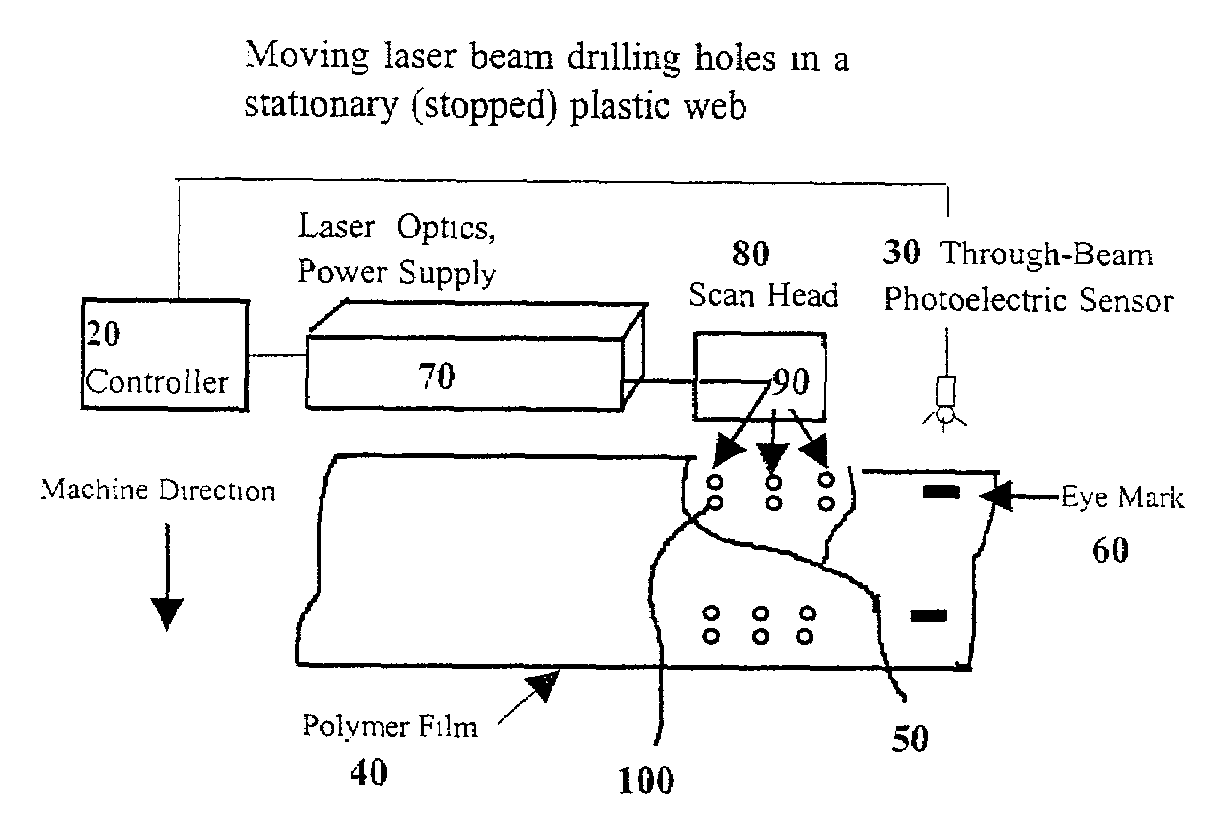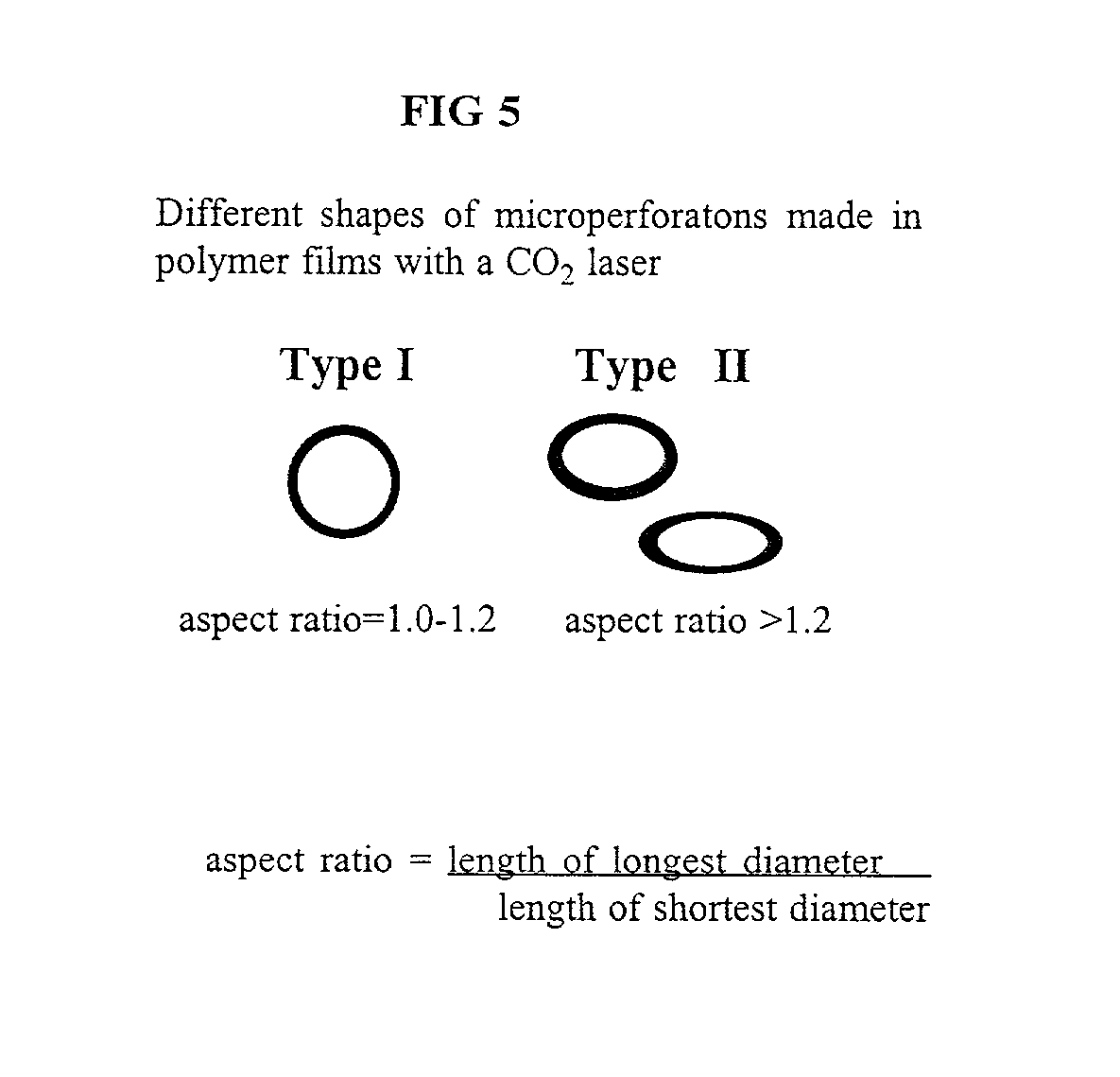Registered microperforated films for modified/controlled atmosphere packaging
a microperforated film and modified/controlled atmosphere technology, applied in the field of packaging, can solve the problems of low otrs, material gas transmission rate, off-odor, off-flavor, etc., and achieve the effect of optimizing the shelf life and quality of respiring foods and optimizing storage li
- Summary
- Abstract
- Description
- Claims
- Application Information
AI Technical Summary
Benefits of technology
Problems solved by technology
Method used
Image
Examples
example 1
[0076]To determine the number and size of microperforations needed for each produce item in a particular package, the gas transmission requirements (O2, CO2, moisture vapor transmission rate—MVTR) for the total package is first determined. The contribution the microperforations must make to the total gas transmission properties of the package is affected by:[0077]produce respiration rate,[0078]weight of produce to be packaged,[0079]desired atmosphere in the package,[0080]breathable surface area of the package,[0081]gas transmission properties (O2, CO2, MVTR) of the packaging material to be microperforated, and[0082]expected storage temperatures during the life of the product.
[0083]Different fresh produce items, whether whole or fresh-cut, have different respiration rates. Cutting the produce item generally increases the respiration rate by 2-fold or more.
[0084]Equations (1), (2), and (3) below can be used to determine the total O2 Flux (FluxO2-Total) requirements of a fresh produce ...
example 2
[0096]Equations (1), (2), and (3) were used to determine the size and number of microperforations needed to maintain an atmosphere of 10–12% O2 and 8–10% CO2 inside a polyethylene pallet bag (125 cm wide×102 cm full gusset×203 cm long×100 micron thick) containing 217.9 kg of fresh sweet cherries at 1.1 C. The OTRbase=1085 cc / m2-day-atm. Ninety-one cm of the bag length will be used to seal the bag by gathering the plastic at the top of the pallet, twisting it, doubling over the neck, and closed tightly with an electrical tie. Therefore, the breathable area of the bag will be 125 cm wide×102 cm gusset×112 cm long.
The equations for this package are:
[0097]OTRT(cc / m2-hr-atm)=(217.9kg×5cc / kg / hr) / (2.54m2×1atm(0.21-0.11)OTRT(cc / m2-day-atm)=4289cc / m2-hr-atm×24hr / day=102,936cc / m2-day-atm.(1)Flux02-film(cc / day-atm)=1085cc / m2-day-atm×2.54m2=2756cc / day-atm(2)Flux02-MP=(102,936cc / m2-day-atm×2.54m2)-2...
example 3
[0100]Equations (1), (2) and (3) were used to determine the size and number of microperforations needed to maintain an atmosphere of 10% O2 and 10–15% CO2 (at 5° C.) inside a 15-cm diameter semi-rigid bowl (0.056 cm thick polyester / PE laminate) containing 227 g fresh-cut cantaloupe and sealed with a flexible heat-sealable lidding film made from a laminate of oriented polypropylene and polyethylene (OTRbase=1550 cc / m2-day-atm). The OTR of the bowl does not contribute significantly to the FluxO2-Total.
The equations for this package are:
[0101]OTRT(cc / m2-hr-atm)=(0.23kg×6cc / kg / hr) / (1.8×10-2m2×1atm(0.21-.10))OTRT(cc / m2-day-atm)=697cc / m2-hr-atm×24hr / day=16,728cc / m2-day-atm.(1)Flux02-film(cc / day-atm)=1550cc / m2-day-atm×1.8×10-2m2=28cc / day-atm(2)Flux02-MP=(16,728cc / m2-day-atm×1.8×10-2m2)-28cc / day-atm=273cc / day-atm(3)
One, Type II 205-micron perforation (produced with a stationary la...
PUM
| Property | Measurement | Unit |
|---|---|---|
| Length | aaaaa | aaaaa |
| Length | aaaaa | aaaaa |
| Fraction | aaaaa | aaaaa |
Abstract
Description
Claims
Application Information
 Login to View More
Login to View More - R&D
- Intellectual Property
- Life Sciences
- Materials
- Tech Scout
- Unparalleled Data Quality
- Higher Quality Content
- 60% Fewer Hallucinations
Browse by: Latest US Patents, China's latest patents, Technical Efficacy Thesaurus, Application Domain, Technology Topic, Popular Technical Reports.
© 2025 PatSnap. All rights reserved.Legal|Privacy policy|Modern Slavery Act Transparency Statement|Sitemap|About US| Contact US: help@patsnap.com



